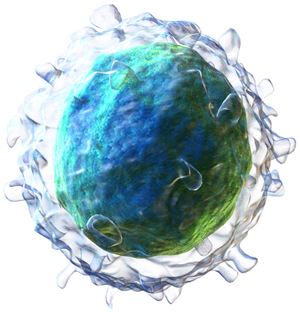Jul. 11, 2014 Research Highlight Biology
An all or nothing proposition
A feedback signaling system forms the foundation for a cellular on–off switch that regulates immune response
 Figure 1: B cells (shown) are a type of lymphocyte that play a crucial role in the immune response. Licensed under CC BY 3.0 via Wikimedia Commons © BruceBlaus
Figure 1: B cells (shown) are a type of lymphocyte that play a crucial role in the immune response. Licensed under CC BY 3.0 via Wikimedia Commons © BruceBlaus
The immune system contains a vast array of cell types and signaling pathways that help to regulate immune response. Among these cell types are B cells, which have the unique ability to bind to specific antigens due to a transmembrane receptor protein known as the B cell receptor (BCR) on the cell surface. Through a combination of biochemical and mathematical modeling experiments, a research team led by Mariko Okada-Hatakeyama from the RIKEN Center for Integrative Medical Sciences has now gained a deeper understanding of the interplay between BCRs and another key component of the immune response, the NF-κB protein complex1.
When a BCR recognizes a potential threat, it sets into motion a series of cellular events that promote a broader immune response. A key step in this process occurs when BCR signaling causes NF-κB to migrate from the cytoplasm to the nucleus, where it directly binds and activates numerous target genes that stimulate B cell maturation and antibody production.
Okada-Hatakeyama and her colleagues uncovered evidence that BCR-stimulated NF-κB activation operates via a binary switch mechanism in which any signal that crosses a set threshold triggers strong, long-lasting activation. Initial cell culture experiments showed that the core machinery of this switch resides in the interaction between two proteins: TAK1 and IKKβ. BCR signaling is initially transmitted from TAK1 to IKKβ, which in turn activates NF-κB. However, the researchers also discovered a ‘positive feedback’ loop, wherein activated IKKβ gives a further boost to TAK1 activation and thereby increases NF-κB activity. Computational simulations supported this model and confirmed that interference with this feedback loop effectively kills the switch-like response.
This on–off signaling mechanism has important functional consequences. “All-or-none responses are very important because after an ‘on’ response it is very difficult to return to the basal state,” says Okada-Hatakeyama. “This means that if a disease state develops, total recovery is very difficult.” These findings could therefore prove helpful in understanding the role of NF-κB in certain cancers or inflammatory disorders. On the other hand, such signaling switches can also confer considerable stability to systems, eliminating the signaling ‘noise’ that can occur in more dynamic signaling networks.
The researchers now hope to explore the final impact of this switch mechanism at the level of NF-κB target gene activity. “We are also planning to rewire and modify this signaling network and see how NF-κB activation and B cell differentiation processes are changed in living systems,” says Okada-Hatakeyama.
References
- 1. Shinohara, H., Behar, M., Inoue, K., Hiroshima, M., Yasuda, T., Nagashima, T., Kimura, S., Sanjo, H., Maeda, S., Yumoto, N. et al. Positive feedback within a kinase signaling complex functions as a switch mechanism for NF-κB activation. Science 344, 760–764 (2014). doi: 10.1126/science.1250020
